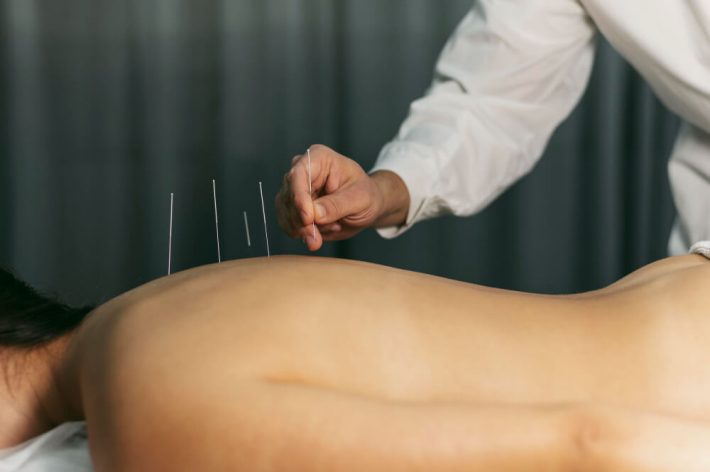
Dry needling and acupuncture both rely on fine, sterile needles, yet they sit on opposite sides of the therapeutic fence. One traces its roots to modern Western anatomy, the other to millennia‑old East Asian medical theory. Understanding where they overlap (and where they diverge) can help you decide which approach best suits your situation. Read on to learn more:
What is Dry Needling?
Dry needling (DN) targets myofascial trigger points—small, tight nodules in muscle that can radiate pain or restrict movement. Practitioners insert a filiform needle directly into these taut bands to prompt a brief “twitch” response; the aim is to relax the muscle, improve local blood flow and dampen pain signals.
Australian physiotherapists adopted the technique enthusiastically over the past decade; a 2023 survey found most private‑practice therapists use DN chiefly to lessen pain and muscle tension. Systematic reviews point to short‑term relief for mechanical neck pain, plantar fasciitis and other musculoskeletal complaints, though researchers still call for larger, high‑quality trials.
How It Works
The prevailing theory is neurophysiological: needle insertion excites A‑delta fibres, alters spinal cord reflexes and promotes endogenous opioid release, producing an analgesic effect. Noranda dry needling sessions usually form part of a wider physiotherapy programme that might include exercise, manual therapy or education.
What Does a Typical Dry Needling Session Feel Like?
- The appointment usually begins with a brief discussion about your current symptoms and any recent changes in activity or training load.
- After locating the tight band of muscle or trigger point, the clinician cleans the area and inserts a single‑use, filiform needle.
- Most people describe the initial sensation as a quick pin‑prick followed by a dull ache or a brief muscular twitch; these responses are expected and indicate that the needle has reached the target tissue.
- Sessions last between 10 and 30 minutes depending on how many regions require attention.
- Immediately afterwards, you may notice a light, “worked‑out” soreness that settles within 24 to 48 hours.
- Gentle stretching, adequate hydration and a warm shower usually ease this post‑treatment fatigue.
- Many clinics schedule a follow‑up visit within a week to reassess range of motion and pain levels, then decide whether further needling is warranted or if the focus should shift to strength and mobility drills.
Although research still investigates the exact mechanisms, current evidence suggests that mechanical stimulation of the trigger point can reset abnormal electrical activity, improve local circulation and modulate pain pathways. For example, runners treated at dry needling Morley facilities often pair the technique with calf‑strengthening exercises to help prevent recurrence of chronic tightness. By integrating needling into a broader rehabilitation plan, you create the best chance of lasting improvement.
Also Read: Understanding Dry Needling – How It Can Help Relieve Muscle Pain and Tension
What is Acupuncture?
Acupuncture arose within Traditional Chinese Medicine (TCM), where health is viewed through the balance of Qi flowing along meridians. Modern biomedical research suggests needling may modulate the nervous, immune and endocrine systems, explaining observed benefits in pain, nausea and insomnia.
Training is considerably longer than DN. In Australia, registered acupuncturists generally complete a four‑year degree and hold current registration with the Chinese Medicine Board of Australia under Ahpra. WHO benchmarks further outline standards for practice and safety worldwide.
Evidence Snapshot
A recent review confirmed moderate evidence that acupuncture improves pain and function in chronic low‑back pain versus usual care. Similar meta‑analyses report benefits for myofascial pain syndromes and tension‑type headaches.
Shared Tools, Different Philosophies
| Feature | Dry Needling | Acupuncture |
|---|---|---|
| Theoretical basis | Western musculoskeletal anatomy; trigger points | TCM meridian theory; holistic balance |
| Typical goals | Local pain reduction, restore range | Pain relief plus systemic regulation |
| Qualification route (AU) | Short courses for registered physios, osteos, etc. | Four-year bachelor’s degree, Ahpra registration |
| Treatment scope | Muscles, tendons, fascia | Musculoskeletal and internal conditions |
Safety and Regulation in Australia
Both methods are safe when performed by trained clinicians, but neither is risk‑free. Mild soreness, small bruises and temporary fatigue are common after DN; systematic reviews put minor adverse events at roughly one in three treatments. Severe complications (such as pneumothorax, deep infection) are rare yet documented.
The Australian Physiotherapy Association recommends regular up‑skilling and at least 20 hours of continuing professional development to practice DN competently. For acupuncture, Ahpra’s national register lets you verify a practitioner’s credentials before booking.
Which One Might Suit You?
Ask yourself:
- Nature of the problem: Localised muscle knot after a long run? DN could settle it quickly. Chronic low‑back pain or migraine? Acupuncture’s broader neuro‑immune effects may help.
- Practitioner availability: DN is now routine in many physiotherapy rooms; acupuncture clinics remain widespread in cities and regional centres.
- Personal comfort: Some people prefer the targeted feel of DN; others favour the calmer, whole‑body framing of acupuncture.
- Cost and cover: Extras health insurance often reimburses either approach when performed by recognised providers. Check your policy details before you sign up for acupuncture or dry needling in Noranda.
Take‑Home Message
Beechboro dry needling and acupuncture share the same stainless‑steel instrument yet differ in philosophy, training and overall scope. Your choice comes down to the issue you want to address, the practitioner’s qualifications and how each approach aligns with your preferences. A well‑informed chat with your GP, physio or registered acupuncturist will steer you toward the option that feels right and safe for you. Search “dry needling near me” online to get started.
